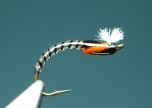Growing up here in Colorado, the Indy 500 was a yearly landmark event. To this day it brings back fond memories of watching the race with my dad (it was one of the few races we tuned into). But it also still reminds me of going hunting. Not for big game, but for worms. On the eve of the race we had a tradition of grabbing a tin can and filling it half full of dirt and then we'd impatiently wait for dark. With flashlights in hand we would creep around a previously wetted lawn to spot and capture night crawlers. Early the next morning we'd wake at dawn and head up the Poudre Canyon for our first fishing trip of the year. Armed with worms from the garden, night crawlers from the lawn, salmon eggs (good ol' Pautzkes Balls o' Fire) and some mepps lures we would hit all of our favorite holes. I absolutely LIVED for that each year - more than my folks realized. My brother and I would carefully prep and tune up our inexpensive spinning rods, save our paper route money to buy needed supplies (new line, hooks, split shot, mepps lures) and then wait for Memorial weekend. We'd watch the Indy 500 and the next day we'd set off for a couple days camping adventure - always up the Poudre Canyon.
With the rivers working their way into full run-off mode, I use the opportunity to focus on our many excellent stillwater fisheries. I'm much more successful fishing rivers than I am on stillwater - it's humbling at first. But I'm gradually improving.
My first float tube trip of the year was today - some private lakes near Red Feather and the day could not have been better. It was cold (38F) but zero wind and completely overcast. Perfect conditions for a hatch and the chironomids did not disappoint! When I arrived the lake was alive with rise forms and surface activity. I looked over the water and could actually see chironomids hatching and escaping from their shucks - it was incredible! Despite this rare (for me) display EVERY other fisherman was plying the water with wooly buggers of various sorts. Most were using intermediate lines and I could see them all doing the strip-strip-pause dance. Totally fine - to each his own. I was not going to spend the moment stripping streamers - since I'll have plenty of chances to do that when the are no observable hatches going on. See that so much action was at the surface, I tied my first chironomid only 12" below a big dry fly used as an indicator and another 12" below that one. I hooked up on my very first cast. Eventually I replaced the indicator dry with an foam indicator to make it easier on my straining eyes. I had steady action, bringing 15 to the net and losing 5 or so. I caught a couple on an olive scud and one on the Denny Rickard stillwater nymph but the best flies for me turned out to be my own versions of a chironomid called Yankee Buzzer that I think was originally invented by famous Scottish tyer Davie McPhail. Dozens of others have claimed to invented similar flies but I think he showed us the way.


Yankee Buzzer (photo: Front Range Anglers) Glass Buzzer - Davie McPhail
The best colors turned out to be:
- black with blue rib
- black with red rib
- olive with brass rib
This is an easy tie - here's how I do it:
hook: #14-16 TMC 2302
body: thread
rib: UTC ultra wire (small)
thorax: thread
wing case: pearl mirage tinsel
wing buds: white goose biots
gills/breathers: Oral-B super floss (you can get it at Walgreens)
1) start thread and wrap a to the bend of the hook. Return thread to 80% point.
2) Tie in rib wire along the hook shank down to the bend of the hook. Return thread to 80% point.
3) Add a layer or two of thread to create a very slight tapered body (don't over-do it).
4) spiral the ribbing wire forward evenly to create the segmented body up to the 75% point.
5) Tie in a 1" piece of pearl flash along the top of the hook - you'll pull this over the thorax and bind it down later.
6) Tie in a goose biot along near and far side of the hook. You'll pull these over along the side of the thorax to form the wing buds.
7) Build up the thorax with thread to form a slight but obvious bulbous thorax. Leave thread about a hook eye width from the eye. You need to leave room for the gills.
8) Pull the biots forward along the sides of the thorax and bind them down beind the eye.
9) Pull the flash over the top of the thorax and bind down behind the eye.
10) Trim the tag ends of the flash and biots as close as you can and hide the ends with a few more thread wraps.
11) cut a 1" piece of floss and bind it down with x-wraps so that it is perpendicular to the hook shank like a bowtie - simiular to a spinner wing. Clip the floss so that about 1/16th inch of floss extends on each side and use your fingers to fluff it out.
12) coat the entire length of the fly on all sides with Loons UV Knot Sense and harden with a UV light.

Great post! I have tied the glass buzzer before. Davie has a video of it on youtube. Glad to see they worked
ReplyDelete